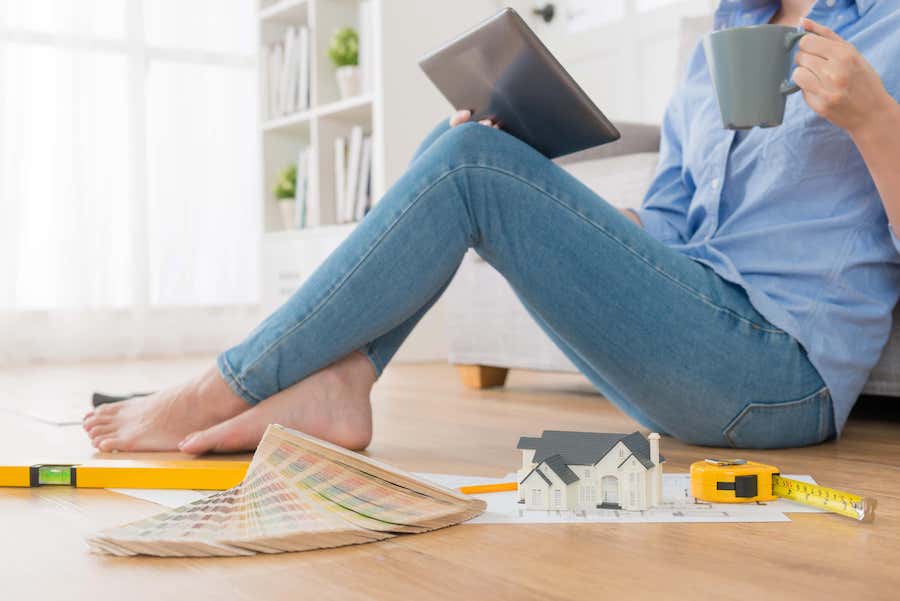How AI can help redesign your home
Interior designers tell us about the pros and cons of using artificial intelligence to transform your living space
Do you have creative ideas for how you’d like the interior of your home to look, but they’re all in your head and likely to remain there?
Or maybe don’t have a clue where to start and are desperate for inspiration.
Artificial intelligence (AI) could be the help you need. AI design tools can redesign your rooms for you in seconds – all you need to do is upload a photo of your room, or supply the measurements, and marvel at how it can show you a realistic representation of how the room could look.
View this post on Instagram
AI-powered design services like HomedesignsAI, the nuie 3D Design Tool, and RoomGPT can also suggest how much the design will cost.
“AI is starting to come into interior design more and more,” says Rob Owen, head of interiors at design studio Manser. “We’re used to seeing polished computer graphics, and AI will only aid in making these even better.”
But he warns: “Homeowners may still find it slightly tricky at this stage, as it depends on having a 3D model of the space or at least some good quality photos.”
Owen points out that some social media apps offer input without the need for AI, but adds: “For simple bits, AI doesn’t cost much, although if it’s being used to create high-definition renders [realistic computer images generated from 2D or 3D models] then it can cost a lot more, as an expert is still required.”

Interior designer Anna Straw says AI tools offer a good starting point for renovations – but they can’t replace the skills of a human interior designer.
“Generative AI is taking the world of interior design by storm,” she observes. “From visualisation to floor planning, applications have quickly sprung up to aid in every step of the design process.
“Many of these tools offer the beginner renovator an exciting starting point to explore styles before launching into their home renovations. However, no tech can ever replace the skills and intuition of a professional interior designer.”
Straw acknowledges that approaching any renovation on your own can be intimidating, but says AI design tools can help build confidence and provide inspiration.
Here, she outlines the benefits and limitations of redesigning your interiors with AI…
Benefits of AI design tools
1. They can incorporate your own style
Some AI tools can analyse current trends alongside your own preferences. Straw explains: “They offer personalised recommendations that match your personal style, and they can also assess the practicality of recreating a certain aesthetic in the space you’re working with, providing tailored inspiration for each room of the house.”
2. Use your space efficiently
View this post on Instagram
It’s hard to know whether any ideas you have for your rooms will work in the space. But Straw says clever AI algorithms will take spatial constraints and user preferences into account when generating layout suggestions for different rooms.
“Automated layout suggestions are a great way to save time and ensure fixtures and furniture are placed in the most user-friendly position,” she explains.
3. Visualise your ideas
You may want to combine certain colours, textures, prints and materials in the room, but be unsure whether the finished look will come together.
But that’s where AI-driven virtual reality (VR) simulations are ideal, says Straw. “These allow users to experience a virtual representation of their design before it comes to life, helping you to make more informed decisions about the layout and decor before committing to certain products.”
4. Make the most of your budget
Interior design mistakes can be costly. But Straw says: “AI tools that allow you to input data like photos, dimensions and other essential details to test your ideas can help to prevent these kinds of hiccups, ensuring your project stays on budget.”
Some AI apps can even provide cost breakdowns and suggest the best products and materials for your budget.
Weaknesses of AI design tools
While design AI offers some amazing opportunities, like all technology, it also has drawbacks and limitations, Straw points out.
1. Many tools have limited functions
Since AI technology is still in its infancy, Straw says many of the current design tools are limited in the capabilities they offer. “The coming years will likely see some fast developments, but at the moment, the effectiveness of AI tools depends on the quality and quantity of data used to train them,” she explains.
2. Ease of use varies
The usability of AI design tools varies depending on how intuitive and accessible the program is, and Straw says: “Some require months of training to master, while others are suitable for beginners who may have never engaged with generative AI before.”
3. AI can’t replace an expert
View this post on Instagram
While AI is becoming more capable, the technology can’t match up to the expertise of a human interior designer and should be regarded as an aid, rather than a replacement, stresses Straw.
“AI tools don’t have the instincts and empathy of human beings, which means they can often overlook the intuitive and creative thinking that goes into creating a dream home,” she says.
“Designing a space involves more than just arranging elements – it requires an understanding of the user’s lifestyle, considering structural constraints and creating the desired mood, and AI can’t understand these complexities.”
She explains that some tools may not understand style preferences that fall outside the data they were trained on, while others may not have the functionality to consider budget constraints.
4. AI output is artificial
Straw warns that AI tools’ practical applications can be limited, and explains: “The imagery created by artificial intelligence is, well – artificial. That means the rooms you design could be unachievable in real life, whether that’s because of restrictions on space, budget, or product availability.
Anna Straw uses the nuie 3D Design Tool to give clients a realistic image of what they can achieve.
The Press Association
Latest posts by The Press Association (see all)
- In Pictures: Party stalwart kept New Labour in touch with traditional supporters - November 21, 2024
- 6 easy indoor exercises to try this winter – and why they are good for you - November 19, 2024
- Martin Clunes: I can’t afford to retire – I’ve got too many horses - November 19, 2024
- How to avoid plant losses, flowering disappointments and container catastrophes - November 17, 2024
- John Lewis Christmas ad stars sister in last-minute dash back in time - November 14, 2024





















